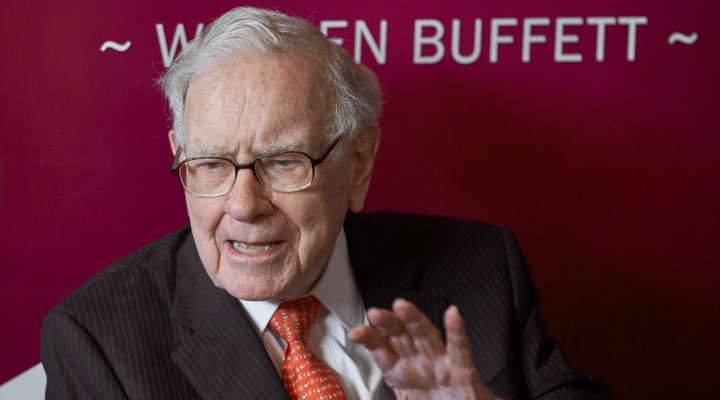
There’s never been a cheaper time to get behind Buffett.
That’s the message from Morningstar analyst Greggory Warren, who warns that with a potential recession looming in the US, shares in Warren Buffett’s investment juggernaut Berkshire Hathaway could be a good long-term bet.
Berkshire Hathaway, has a cache of nearly US$100 billion in dry powder that could be committed to investments, acquisitions and share repurchases, Warren says.
The investment conglomerate's shares are currently undervalued in a market that is fairly valued, and the famous conglomerate is trading at a 20 per cent discount to Morningstar’s fair value estimate.
“It's the cheapest we can remember seeing them in years, providing a good entry point for long-term investors,” Warren says.
Shares in the company are split into two tiers: Class A (BRK.A) (fair value estimate: US$380,000) and Class B (BRK.B) (US$253). Class B shares were introduced in 1996 to allow investors to buy the stock directly instead of having to go through unit trusts, or mutual funds that mirror Berkshire Hathaway's holdings.
Five reasons to back Berkshire
Recession fears are intensifying amid geopolitical tensions, while Goldman Sachs Group economists see rising recessionary risks as the US-China trade war drags on.
“What investors are coming to realise is that the goingson outside US borders is having an impact on global as well as US economic growth,” said Paul Nolte, portfolio manager at Kingsview Asset Management in Chicago.
“Investors are coming around to the fact that no matter where interest rates get pegged it will not mitigate the trade issues.”
Data on inflation, housing starts and retail sales are due later in the week, and will be scrutinized for further signs of economic softening.
Against that backdrop, Morningstar’s Warren cites five key reasons to list Berkshire as a long-term play:
- Diversification
- Strong balance sheet
- Capital allocation
- Excess returns
- Attractive valuation
The Berkshire empire draws its strength from investing in a broad group of industries, spanning property-casualty insurance to railroads, utilities and pipelines, and manufacturing, service, and retailing.
Each of the 90 or so companies under the Berkshire umbrella has sustainable competitive advantages.
A key engine room for growth is the company’s insurance operations – Geico, Berkshire Hathaway Reinsurance Group, and Berkshire Hathaway Primary Group account for close to 40 cent of Berkshire’s overall fair value.
Then there’s the railroad utilities and energy segment. The Burlington Northern Santa Fe subsidiary, for instance, is the parent company of BNSF Railway – the largest freight network in North America. Alongside that is Berkshire Hathaway Energy, a holding company with a diversified portfolio of energy providers.
Together, the Burlington Northern Santa Fe and Berkshire Hathaway Energy subsidiaries contribute 28 per cent to Berkshire Hathaway’s overall fair value.
An arms-length operation
Another key factor in the company’s investing power is its decentralised nature. Buffett and his partner Charlie Munger are as hands-off as possible.
They allow managers to run their own show, and ensure they are responsible for setting their own budgets and allocating capital.
“The only request from corporate is to pass along their excess capital when it can’t be put to work in value-enhancing projects,” Warren says.
And this is when Buffett and Munger come into their own, minimising tax where possible and shifting large amounts of capital from businesses that have limited incremental investment opportunities into other subsidiaries that look like better bets.
This in turn bolsters the balance sheet, which is another competitive advantage. And investors have learned to trust Buffett and Munger, safe in the knowledge that if they’re withholding cash it’s because they’re pumping it back into money-making opportunities.
These same cash reserves have been deployed to support and grow Berkshire's insurance operations and also to seize on well-priced acquisitions.
Warren says the company is on track to generate returns in excess of its estimate of its cost of capital.
“Book value per share, which serves as a good proxy for measuring changes in Berkshire's intrinsic value, increased at a 9.5 per cent, 11.7 per cent and 10.1 per cent compound annual growth rate the past five-, 10-, and 15-year time frames.
“We believe the advantages provided by Berkshire's business model should allow the firm to expand book value (and returns on equity) at a high-single- to low-double-digit rate in the near-to-medium term.”
Returing cash to shareholders
And while Berkshire is famed for pumping cash back into the business, investors are seeing rewards.
“Berkshire is becoming a vehicle for returning capital to shareholders. The company was sitting on US$122 billion in cash as of the end of the second quarter and is expected to generate US$5 billion−US$10 billion a quarter in free cash flow going forward.
“It will be only a matter of time before the firm hits the US$150 billion cash threshold Buffett said he would find difficult to defend.
“While there have been repurchases of late, we're well off the US$10 billion−US$15 billion average annual run rate we believe will be necessary to keep Berkshire's cash balances in check and enhance shareholder value.”



















